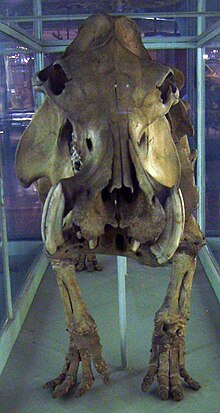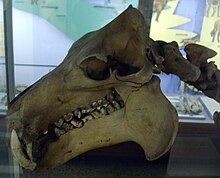Malagasy hippopotamus
| Malagasy hippopotamus | |
|---|---|

| |
| Hippopotamus lemerlei skeleton at the Museum für Naturkunde, Berlin | |
| Scientific classification | |
| Domain: | Eukaryota |
| Kingdom: | Animalia |
| Phylum: | Chordata |
| Class: | Mammalia |
| Order: | Artiodactyla |
| Family: | Hippopotamidae |
| Subfamily: | Hippopotaminae
|
| Genus: | Hippopotamus |
| Species | |
Several species of Malagasy hippopotamus (also known as Malagasy pygmy hippopotamus or Madagascan pygmy hippopotamus) lived on the island of Madagascar but are now believed to be extinct. The animals were very similar to the extant hippopotamus and pygmy hippopotamus. The fossil record suggests that at least one species of hippopotamus lived until about 1,000 years ago[3] and other evidence suggests that the species may have survived until much more recently.[4] The taxonomy of these animals is not resolved and not widely studied.[5][6]
Discovery and taxonomy
The Malagasy hippopotamus was first described in the mid-19th century by
The fossil record of the Malagasy hippopotamus is extensive. At least seven hippopotamus bones show unequivocal signs of butchery, suggesting that they survived until humans
Species
Although not well-studied, there is growing acceptance of three species of Malagasy hippopotamus.[10][3][11] It is not known when or exactly how these hippos arrived on the island of Madagascar. As hippos are semi-aquatic, it is possible that they survived the 400 km (248 mi) trek across the channel, although presumably when the water was shallower and there were perhaps small islands along the way. It is possible that the three species of hippopotamus represent three distinct and successful migrations to the island.[11] Hippos are the only endemic ungulates ever to have lived on Madagascar.
Hippopotamus lemerlei

Hippopotamus lemerlei bones have been mostly discovered in the rivers and lakes of western Madagascar, suggesting a
Although a clear relative to the common hippopotamus, H. lemerlei was much smaller, roughly the size of the modern
Because H. lemerlei reached its size through dwarfing, it is properly known as the Malagasy dwarf hippopotamus, though this term is sometimes applied to the other species of Malagasy hippos. Bones of H. lemerlei have been dated to about 1,000 years ago (980±200 radiocarbon years before present[6]).

Hippopotamus madagascariensis
Also called the Malagasy pygmy hippopotamus, this species was originally classified as Hippopotamus along with H. lemerlei, and indeed the two species were roughly the same size. A review of their morphology and habitat, however, suggested a closer relationship to the modern pygmy hippopotamus.
Like the modern pygmy hippopotamus, the Malagasy pygmy hippo had eyes on the side of its head rather than high orbits and teeth of the common hippopotamus. The Malagasy pygmy hippo was similarly less aquatic, with many of its fossils found in the forested highlands of Madagascar.[8]
Fossils of both the Malagasy pygmy hippopotamus and H. lemerlei show a cursorial adaptation, distinct from the hippos on the African continent, and they would have been much better runners. This common trait is a possible indicator that both species of Malagasy hippo descended from a common ancestor, and that the similarities to the modern hippopotamus and pygmy hippopotamus are a case of parallel evolution.[11]
The Malagasy pygmy hippopotamus is classified along with the modern Liberian pygmy hippopotamus, but researchers sometimes place the Liberian hippo in two different genera. The pygmy hippopotamus was originally classified as
Hippopotamus laloumena
In 1990, Faure and Guerin described a third species of Malagasy hippopotamus, Hippopotamus laloumena ("laloumena" is a
The fossils clearly belong to a hippopotamus, but one much larger than any previously described Madagascan species. From what is known, the species closely resembled the modern hippopotamus, but was somewhat smaller.[11]
It is the oldest of Malagasy hippopotamus to range in the Pleistocene epoch.[14]
Diet
A study demonstrating Malagasy hippopotami and contemporary Aldabrachelys tortoises dietary habits indicates that H. lemerlei and tortoises were the dominant grazer guild in Madagascar. Malagasy hippos in general however were less grass-specialised than the mainland African hippo.[15] However, other studies contradict these conclusions and suggest that grasses were only a minor component of the diets of Malagasy hippopotamuses.[16]
Oral legends and the kilopilopitsofy
Limited fossil evidence for the Madagascan hippopotamus is younger than 1,000 years old. However, the hippopotamus has been surprisingly common in the oral legends of the Malagasy. In 1648,
In the 1990s, Burney, who was studying recent extinctions in Madagascar, collected tales about a creature called the kilopilopitsofy that had been described by villagers in the town of Belo-sur-mer, a small fishing village on the west coast. Several villagers independently described an animal that, as recently as 1976, had entered their village, was the size of a cow, was dark pigmented, grunted a lot, and when threatened, fled underwater. No known animal on Madagascar fits the description but the animal seemed remarkably like a hippopotamus.[4]
One man in the village could accurately mimic the sound of many animals, and when asked to imitate the kilopilopitsofy, he made noises very similar to that of a hippopotamus, even though he had never left the island and said he had never seen an African hippo. When shown photos, others also identified a hippopotamus-like animal, but with larger ears. Several described the creature's last appearance in 1976.[4]
Burney was reluctant to publish the study for fear of being labeled a cryptozoologist, but eventually published the results in American Anthropologist. Burney concluded that while the villagers had possibly encountered a Malagasy hippopotamus, it was also possible that the stories were inaccurate—a combination of misidentified animals, old folk traditions, and information the villagers had gathered from modern paleontology.[4][8]
References
- ^ .
- ^ a b Faure, M. & Guerin, C. (1990). "Hippopotamus laloumena nov. sp., la troisième éspece d'hippopotame holocene de Madagascar". Comptes Rendus de l'Académie des Sciences, Série II. 310: 1299–305.
- ^ IUCN. Archived from the originalon 2008-01-02.
- ^ JSTOR 681820.
- ^
- ^
- ISBN 978-0-380-97577-8.
- ^ ISBN 978-0380794652.
- ISBN 978-0198573999.
- ^ a b Oliver, W.L.R. (1995). "Taxonomy and Conservation Status of the Suiformes — an Overview" (PDF). IBEX Journal of Mountain Ecology. Archived from the original (PDF) on 2007-07-05.
- ^ ISBN 978-0-85661-131-5.
- ^ Coryndon (1977). "The taxonomy and nomenclature of the Hippopotamidae (Mammalia, Artiodactyla) and a description of two new fossil species". Proceedings of the Koninklijke Nederlandse Akademie van Wetenschappen. 80 (2): 61–88.
- .
- . Retrieved 2022-12-24.
- PMID 27383816.
- ISSN 2572-2611.
External links
- Pictures of a Malagasy hippopotamus skeleton on display at the Paleontological Museum at the University of Oslo.
